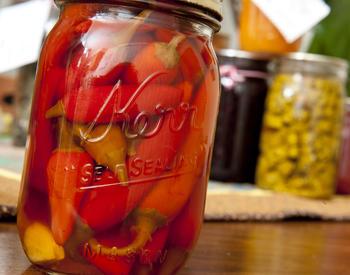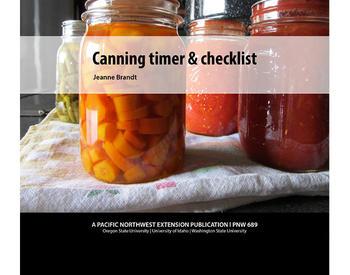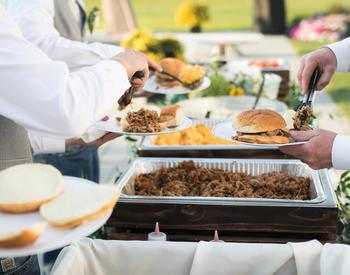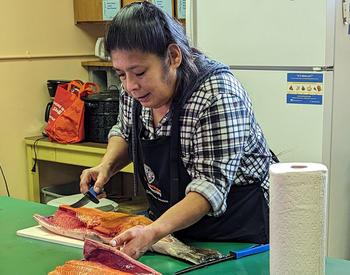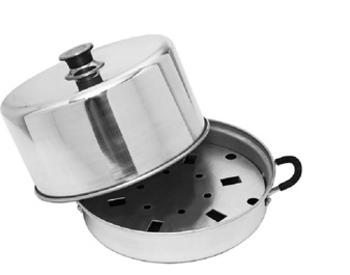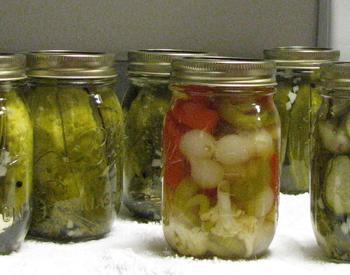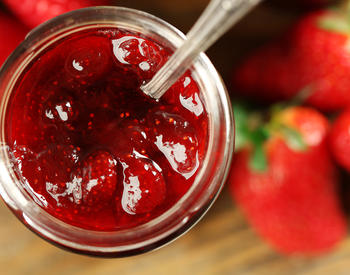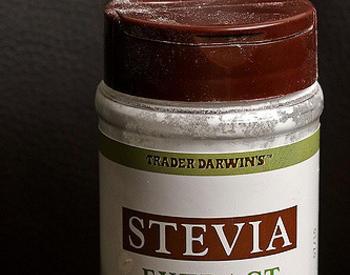Download this publication as a PDF
It’s 9 p.m. As you turn on the TV to watch your favorite show, your stomach feels funny. You’re soon running to the bathroom. Don’t assume that it’s the 24-hour flu. It may have been something you ate!
You probably won’t feel sick right after eating “spoiled” food. It takes time for the bacteria (germs) and their toxins (poisons) to “work” in your intestines. Some bacteria can make you sick in just 2 hours. Others won’t “strike” for several days.
Sometimes symptoms (such as nausea and/or diarrhea) last just 24 hours. Others last for a week or more. Side effects of botulism (the most harmful type of food poisoning) can last for years.
Some people may be sicker than others because their immune systems are weak. Pregnant women, infants and young children, older adults, and people with cancer, AIDS and other diseases are more at risk.
It’s important to see a doctor if symptoms are severe or last a long time. Doctors can do tests to track down the bacterial culprit.
If symptoms are mild, you might want to do your own detective work. The chart below describes seven types of bacteria that most often cause foodborne illnesses. To determine if one of these is the culprit, think about these clues:
What are my symptoms?
Although nausea and diarrhea are common, the symptoms depend on the type of bacteria.
How long did my symptoms last?
Staphylococcus bacteria cause food poisoning that may seem like the 24-hour flu. Perfringens poisoning lasts just a short time, too. Other types often last longer. You’ll probably need to see your doctor.
What type of foods did I eat during the last 24 hours that could have been a source of bacteria?
Food-poisoning bacteria love cooked foods that are high in protein (such as meats, chili, pasta salad and custard). If these foods sit at lukewarm temperatures for more than 2–3 hours, bacteria can start to grow.
Rare or undercooked foods from animals (meats, poultry, eggs, seafood) can be a source of harmful bacteria, too. So is raw (unpasteurized) milk. Heating kills most bacteria and their toxins (poisons).
Another common cause of foodborne illness is cross-contamination (spread of bacteria from raw meat, seafood and poultry to other foods that aren’t cooked before eating). This can happen when lettuce is put on a cutting board that has not been cleaned after cutting up chicken.
How long has it been since I might have eaten spoiled food?
This can be hard to tell. Don’t assume that it was something you ate away from home. If the time has been short, Staphylococcus bacteria are probably responsible.
Prevent food poisoning!
Keep it clean!
Wash your hands with soap and water before handling food — especially after using the toilet or changing diapers.
Wash counters, cutting boards, and utensils with soap and water after handling raw meat, poultry, seafood and eggs. After washing, wipe or spray with diluted bleach solution (1 tablespoon in one gallon of water).
Don’t sneeze on food. Bandage cuts on hands. Keep insects, rodents and pets away.
Cook it well!
Cook meat, poultry, fish and eggs thoroughly. This is how they should look:
- Ground meat is brownish.
- Poultry meat is light or dark brown and its juice is clear.
- White fish looks milky and flakes easily with a fork.
- Egg whites are white and firm.
Drink pasteurized milk and fruit juice (heat-treated to kill harmful bacteria).
Cool it soon!
Keep hot foods hot and cold foods cold.
Cool big pots of soups and stews by pouring them into shallow pans (2 to 3 inches high). Refrigerate soon.
Some types of foodborne illness
|
|
Botulism |
E. Coli 0157:H7 Poisoning |
|
Cause |
Clostridium botulinum bacteria |
E. coli 0157:H7 bacteria |
|
Examples of food involved |
Meats, fish, vegetables and poultry that have not been canned properly or refrigerated promptly after cooking |
Undercooked ground beef, raw milk |
|
Type of symptoms |
Seeing double, trouble swallowing, trouble speaking and breathing. Antitoxin is needed for recovery. |
Cramps, bloody diarrhea and nausea. Can result in kidney failure and death. |
|
How soon symptoms start |
Usually 12 to 36 hours |
Usually 3 to 9 days |
|
How long symptoms last |
Recovery takes months or years |
4 to 10 days |
|
|
Listeriosis |
Vibriosis |
|
Cause |
Listeria monocytogenes bacteria |
Vibrio parahaemolyticus bacteria |
|
Examples of food involved |
Raw milk, unripened and other soft cheese, undercooked meat and poultry |
Raw seafood such as oysters, shrimp, crabs and clams |
|
Type of symptoms |
Headache, fever, and nausea. Can lead to meningitis. Can result in miscarriage or still birth. Antibiotics are needed for recovery. |
Diarrhea, cramps, nausea, weakness, chills and headache |
|
How soon symptoms start |
Usually within 24 hours. Can occur up to 12 days after eating |
3 to 76 hours (average of 17 hours) |
|
How long symptoms last |
2 to 7 days |
1 to 8 days |
|
|
Salmonellosis and Campylobacteriosis |
Perfringens poisoning |
|
Cause |
Salmonella and Campylobacter bacteria |
Clostridium perfringens bacteria |
|
Examples of food involved |
Undercooked or raw poultry, red meat, eggs, and dairy products |
Cooked meat and poultry, stews, refried beans, soups, and gravies cooled slowly |
|
Symptoms |
Vomiting, diarrhea, cramps, and fever. Severe infections cause high fever and may even cause death. |
Diarrhea, cramps, gas |
|
How soon symptoms start |
Usually within 12 to 36 hours |
Usually within 8 to 20 hours |
|
How long symptoms last |
2 to 7 days |
Up to 24 hours |
|
|
Staphylococcal poisoning |
Norovirus infection |
|
Cause |
Staphylococcus aureus bacteria |
A group of similar viruses. |
|
Examples of food involved |
Cooked meat, poultry and ham, potato salad, pasta salad, custard |
Contaminated shellfish; ready-to-eat foods touched by infected food handlers; contaminated water |
|
Symptoms |
Vomiting, diarrhea, cramps, weakness |
Nausea, vomiting, diarrhea, abdominal pain |
|
How soon symptoms start |
Usually within 2 to 8 hours |
Usually within 24 to 48 hours |
|
How long symptoms last |
1 to 2 days |
24 to 60 hours |
Source: OSU Master Food Preserver Program
